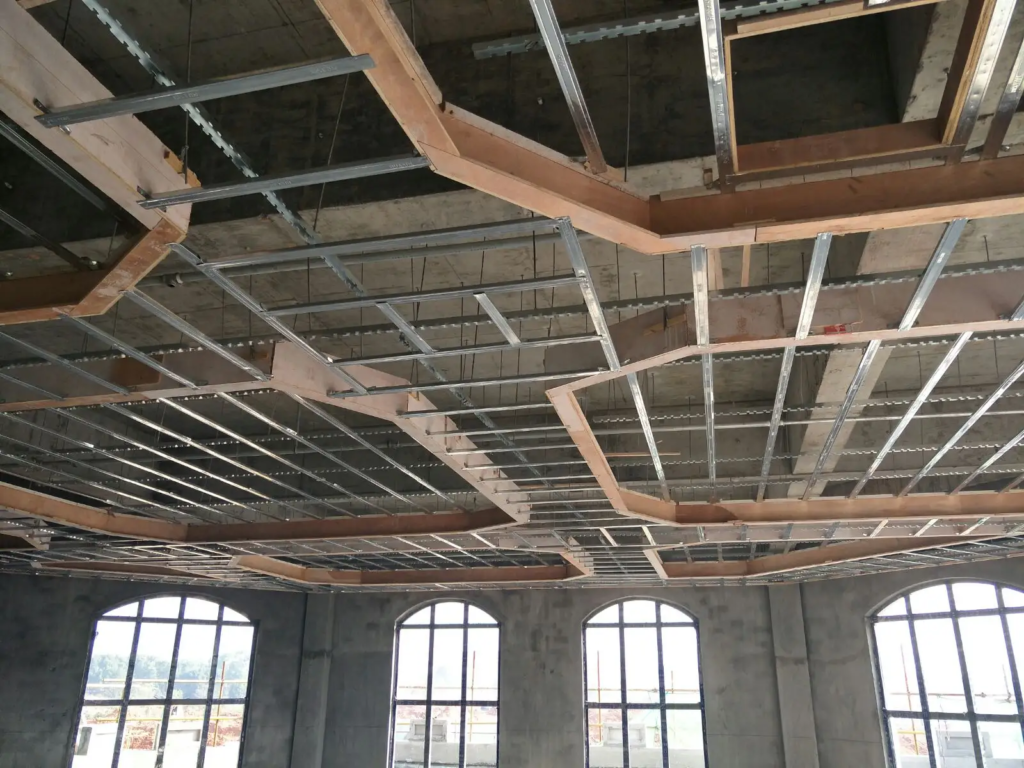
Introducing Ceiling Steel Profile and Plasterboard: A License to Play It Safe. These systems provide exceptional fire resistance, noise reduction, and ease of installation. However, the common bane is fissuring – a significant aesthetic downgrade. So why do these cracks form, and can they be sidestepped? Let’s dig deeper!
Maintaining the integrity of a steel profile particleboard ceiling is essential for its longevity. Some causes can lead to cracking over time, but understanding these can save significant effort and expense. Three common culprits include physical impact, moisture intrusion, and thermal expansion and contraction. By addressing any underlying issues quickly, you can mitigate further damage to your ceiling.
Post-installation problems with improper ceiling features and plasterboard mounting can lead to extensive stress accumulation beyond the screws’ ability to withstand it. This, in turn, can cause severe plate joint fissures.
In the field of construction management, effective communication and accountability are essential to prevent operational fragmentation and relentless non-compliance. These omissions can precipitate moisture-induced gypsum board fissures that prove costly to correct. Ensuring cross-functional collaboration across systems is therefore paramount in avoiding such vulnerabilities.
In the construction world, improper application of putty can lead to unsightly cracks. This is not only due to improper mixing, but also the mismatch of materials such as gypsum boards and wood plywood that leads to expansion/contraction problems. These cracks can also be caused by episodes of rapid drying, long seams, prolonged feeding times, or excess putty layer thickness. Therefore, a watchful eye must always be kept on these factors to ensure quality construction.
In today’s dynamic business environment, we often find ourselves indoors amid artificially regulated temperatures and humidity levels. These parameters can vary greatly from our usual comfort zones, disrupting the delicate balance within building materials such as plastered walls and ceilings. As a result, a lack of moisture can cause surfaces to lose moisture, resulting in surface cracks, especially in areas like the Central Plains where climates are particularly dry. Damage is also a possibility for gypsum ceiling steel profiles left exposed to high humidity outdoors or in vibrating spaces. It is vital to consider these factors when designing and maintaining indoor spaces to prevent structural damage and ensure safety.
Today’s topic is about the standard mitigation processes for repairing certain problems related to gypsum board ceilings. Understanding these steps can help you effectively address similar issues at your place of residence or work.
- To ensure proper acoustical board attachment, it is essential to install the board firmly. The wire should be laid before mounting clips, ensuring their vertical position. The installation procedure of the ceiling steel profile follows by connecting the main channel to its bottom through a suspension unit, secured by screws and a plug-in mechanism. It is essential to achieve a flat and stress-free ceiling, free from any distorted, jutting edges.
- In the prelude to initiating projects, our main focus has been on instilling a strong sense of responsibility within operators through robust post-training. As critical steps are taken, such as the installation of diamond saws or the replacement of gypsum panels, we ensure that strict checks are carefully carried out by construction personnel, enhancing rigor and precision. Deviations from standardized methods require prompt remedial action instigated by the operational team. Such preparations pave the way for the successful implementation of critical construction processes while maintaining the highest standards of quality control.
When applying plaster, it is essential to be mindful of the overall thickness and avoid applying too much as it may hinder proper filling. Also, for patchwork work, consider dividing the plaster into manageable chunks. This helps to achieve an even surface, thus reducing any unevenness that may occur due to improper application.
During the process, remember not to use soaked plaster, as this can cause delays in drying, leading to night crevices, depressions, or hollow drums, which can escalate further into damaged surfaces. Pay special attention to corners, joints between gypsum board/ plywood, and masonry walls as they tend to dry quickly and crack easily. Remember, prevention is better than cure!
When it comes to maintaining a fault-free ceiling, the use of high-quality ceiling steel profile plasterboard is paramount. Not just limited to conventional paper-based plasterboards, factors such as variations in wind speeds and ceiling topography must be considered when selecting them. In addition, fitting the correct sections of the ceiling steel profile with appropriate gaps can significantly enhance its durability, while repelling weather, environmental humidity, and heavy machinery noise. Choose wisely, and your ceiling stands the test of time!

